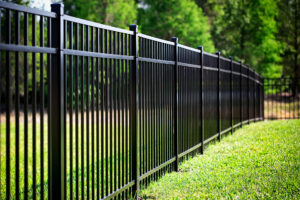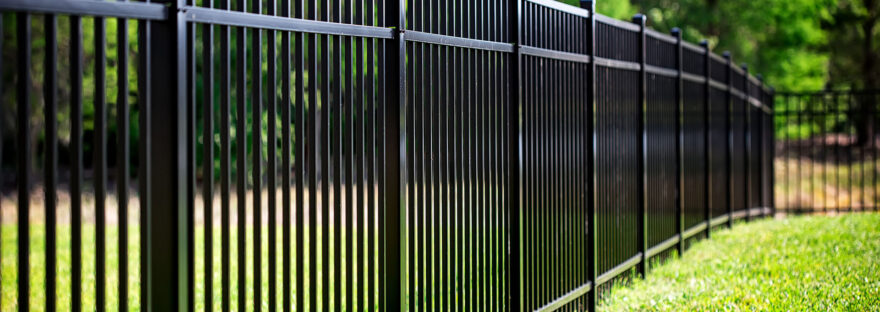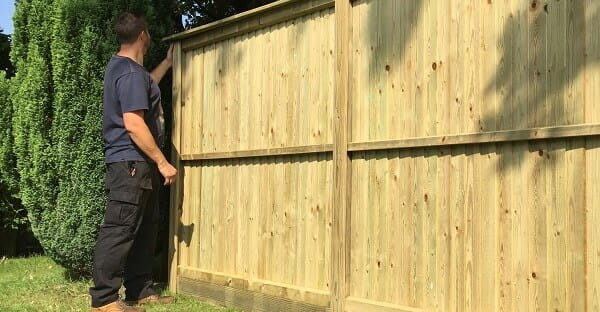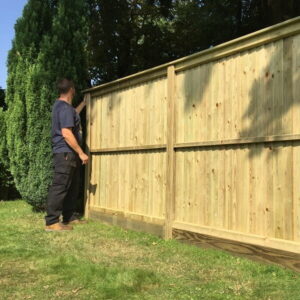Aluminum Fences NJ are a beautiful choice for any home or commercial property. They’re also very functional and more practical than other types of fencing materials.
They’re durable enough to stand up to anything a family throws at them, from soccer balls to lawnmowers. They’re even suitable for high-traffic areas, like warehouse gates or shipping-and-receiving docks.
Aluminum fences are one of the most durable fencing options available today. They are far more corrosion-resistant than wrought iron and can withstand a lot of wear and tear without becoming damaged. They are not as strong as steel, however, and may not be able to stop an intruder from climbing over or through them.
Aluminum is also far more flexible than steel, making it much easier to shape into different designs for home and business use. This flexibility means that you can find a style to match any architectural style, from traditional to modern and everything in between. In fact, many people choose aluminum for their fencing because of its unique look that can be a great way to boost the curb appeal of any home or business.
Another important benefit of aluminum is that it is environmentally friendly. It does not need any protective surfacing like wood does, and it can be recycled if you ever decide to remove it from your property. In addition, it is less likely to rust or be damaged by rain than other types of fencing materials, which can damage the grass, dirt, and plants below them.
In addition to its durability, aluminum is a very cost-effective option. It is lighter than steel, which means that it can be shipped more easily and costs significantly less to produce. This makes it a more affordable choice than other fencing materials, which often need to be coated in expensive protective surfacing and painted multiple times to withstand the elements and everyday wear and tear. Even better, most of our aluminum is made in the states rather than being imported from overseas manufacturers that have a reputation for cutting corners in production.
Weather Resistant
Aluminum is one of the most weather-resistant fence materials available today. It stands up to rain, snow, sleet, and ice with ease and won’t crack or rust like other metals. It also resists deterioration from the sun’s UV rays, as well as insect infestation and decay. Many aluminum manufacturers offer a lifetime warranty on their fence products because they withstand wear and tear so well. They outlast wood, chain-link, and wrought iron fencing, making them the most economical option for long-term use.
Many people opt for an aluminum fence because it looks similar to wrought iron and steel models, but at a more affordable price. They also come in a variety of styles and heights to suit your needs.
If you want your aluminum fence to look more like a decorative gate, you can add scrolls and ornamentation. These decorations range from ornate finials, such as the quad flare or triad, to more simple attachments, such as fleur-de-lis or straight or curved lancet style toppers.
The beauty of an aluminum fence is that it can complement almost any home, whether the house is contemporary or traditional. Some of the most popular designs include spear points and a modern double-rail design. The spear points of these fences can be set at varying heights to give them more personality.
If you live in a coastal area, you may need to worry about salt spray damaging your metal fence. This is because cars drive on the road during winter, and the tires kick up salt spray that can chip or damage the paint or coating of a metal fence. Fortunately, aluminum is resistant to corrosion due to its natural properties.
Easy to Install
Aluminum is much lighter than steel and wrought iron fences, making them easier to transport and install. It is also more cost-effective than wood fencing, allowing you to afford more attractive styles. You can find recycled versions of aluminum fences as well, which will help to reduce your environmental footprint.
In addition, this fence type is easy to install on any property, including sloping areas. This is because it adapts to the lay of the land and does not require a completely flat surface to function properly. This eliminates a stair-step appearance and large gaps at the bottom of the fence, which could allow pets or small children to slip underneath.
During installation, it’s best to set your aluminum fence posts in concrete rather than gravel or soil. This will ensure that the posts stay upright and sturdy, even over time. Be patient while the concrete sets, as it may take up to a week for the proper results. Trying to rush the process will result in improperly secured posts that could eventually bend or break.
You will also want to check with your local municipality and utilities companies before digging any post holes. There may be underground lines in the area that can be disrupted by a fence, so it’s important to avoid these and have them marked before you begin construction. You will also want to learn what the zoning regulations are for your neighborhood and whether or not you need a permit before beginning your project.
Once the concrete has set, you can insert your fence sections. The rails fit into the notches in the posts and are secured with self tapping screws. The next section is connected to the adjacent post, and so on. For gate posts, the notches are larger to support the weight and latching of the gate.
Aesthetics
Aluminum fences are available in a wide range of styles and finishes that complement various architectural styles. These fences add a unique aesthetic to the home or business and can raise curb appeal. Unlike wooden fences, which may be susceptible to rotting or insect damage, aluminum is corrosion resistant. Moreover, the metal is not subject to water damage, which makes it the ideal material for outdoor installations.
The design of an aluminum fence can be as simple or as ornate as you want. The more ornate options have scrollwork and eye-catching finials that add a classic look to the property. Other fence styles have a more contemporary appearance, featuring sleek profiles and clean lines. These are ideal for individuals who prefer a minimalist aesthetic or want to accentuate the architectural features of their house.
An important consideration when choosing an aluminum fence is the color. The fence should match the color of the house for a cohesive look. Some aluminum fences are powder coated in custom colors, allowing you to choose the perfect shade for your home or business. For example, if your house has warm undertones, you can choose fencing with the same tone, such as glossy black or one of the metallic finishes.
In addition to their conventional functions, aluminum fences can be used in innovative ways to improve the functionality of your property. These creative applications include decorative walls, one-of-a-kind art exhibits, privacy screens, safe pet cages, and supporting trellises for climbing plants.
Many aluminum fences are made from recycled materials, making them a green choice for your home or business. Additionally, they require less maintenance than other types of fences, so you can save on time and money spent on repairing and repainting.
Low Maintenance
Aluminum fences do not require a lot of maintenance like iron or wood does. In addition, they are not prone to the problems of rust and fading that can be found in many other fences. Aluminum fences are also eco-friendly. They are made from recycled materials and are a good option for homeowners who want to reduce the amount of trash they send into landfills.
The light weight of aluminum makes it easier to install compared to other fence materials like iron or steel. This may lead to less labor costs during installation and can save you money in the long run.
Most aluminum fences are manufactured in a wide variety of styles and finishes that will match any property’s aesthetic. They can be used for almost any outdoor area, from enclosing a pool to bordering the front yard. Aluminum fences are also a good choice for sloped properties as they can easily adapt to the incline of the land.
The sturdiness of aluminum fencing means that it is hard to dig under or climb over, which can provide an extra level of security for your home and family. This is particularly important if you have pets or children. An aluminum fence will not bend under pressure, and it will keep small animals away from the pool or garden areas. Additionally, it can be designed with safety latches to prevent kids or pets from opening the gates while adults are not around.
Because of the durability, low maintenance, and beauty of aluminum fences, they are an excellent investment for any home. They can increase the resale value of your property and offer a safe environment for your loved ones.


